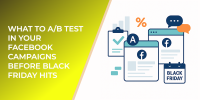Modern e-commerce thrives on abundance. But here’s the challenge: when shoppers face too many choices, they often freeze instead of buying. This is the paradox of choice — and it plays a major role in how Facebook and Instagram ads perform.
So, should advertisers pack ads with variety, or keep things simple? The answer depends on how you structure your campaigns. Let’s break it down.
What Is the Paradox of Choice in Online Shopping?
The paradox of choice happens when having more options actually makes people less satisfied with their decision — or prevents them from making one at all.
This effect shows up in e-commerce ads all the time:
-
A shopper sees 15 different jackets in a carousel ad.
-
Instead of clicking, they hesitate, comparing and second-guessing.
-
The result? They move on without buying anything.
It’s a real problem for advertisers. Instead of boosting sales, abundance sometimes slows them down.
If you’re struggling with this in your campaigns, it helps to revisit how Facebook ad targeting has evolved. See Facebook Ads Targeting Updates: How To Adapt in 2025 for a deeper look at the recent shifts.
Why Too Many Options Hurt Ad Performance
Offering variety looks good on the surface. It signals that your brand has something for everyone. But in practice, showing too much at once creates friction.
Typical issues when ads include too many choices:
-
Lower click-through rates — people feel overwhelmed and keep scrolling.
-
High bounce rates — visitors land on busy pages and leave without exploring.
-
Cart abandonment — shoppers add items but stall when faced with too many variants.
-
Decision fatigue — the mental effort of comparing leads to inaction.
These are signals that your ads may be drowning in choice overload. If performance metrics look strong at the impression level but weak at the conversion stage, this imbalance is worth investigating.
Why Fewer Options Can Boost Conversions
On the other hand, narrowing focus helps buyers feel more confident. When ads emphasize just one or two products, decision-making feels easier and less risky.
Advantages of showing fewer options in ads:
-
Shoppers spend less time comparing and more time buying.
-
A single strong offer builds urgency and clarity.
-
Focused ads often align better with quick social media browsing habits.
Picture this: an Instagram ad that spotlights one best-selling jacket with a clean design and limited-time discount. The shopper doesn’t get lost in endless comparisons. They simply decide yes or no — and that simplicity can raise conversion rates dramatically.
How to Balance Variety and Simplicity in Ads
The paradox of choice doesn’t mean you should always cut options. Sometimes variety works, especially in awareness campaigns or for complex products that buyers expect to compare. The key is balance.
Ask yourself:
-
What’s the campaign objective? Awareness campaigns benefit from variety, but conversion-focused ads thrive on simplicity.
-
How complex is the product? High-tech items may need comparison, while fashion often sells best when one option is highlighted.
-
What’s the buying stage? A first-time visitor may want to browse, while a retargeted shopper is more likely to respond to one strong offer.
Finding this balance is less about following rigid rules and more about understanding your audience’s mindset and adjusting the number of choices to match their intent.
Practical Tips to Apply the Paradox of Choice in Ads
Understanding the paradox is useful, but execution is what drives results. Here are several strategies advertisers can test, with concrete examples of how to apply them.
1. Test different carousel lengths
Run two versions of the same ad set:
-
One with 3–4 products (focused on bestsellers).
-
Another with 7–8 products (showing a wider range).
Compare CTR, CPC, and purchases. Shorter carousels often win, especially on mobile.
2. Feature a clear “hero” product
Choose one product to lead the ad — your bestseller, seasonal favorite, or high-margin item. Supporting items can appear in secondary placements but should never distract from the star.
3. Segment your audience for precision
Instead of showing everything to everyone, divide campaigns by interest groups:
-
Fitness enthusiasts → performance shoes.
-
Students → casual sneakers.
-
Professionals → minimalist office styles.
This keeps ads lean and relevant. For more targeting inspiration, see Custom vs Lookalike Audiences: What Works Best for Facebook Campaigns?.
4. Manage your dynamic product ads carefully
Audit your product catalog regularly. Remove items with poor reviews or low conversion rates. Keep ads focused on winners.
5. Simplify your landing pages
Your ads might show multiple products, but the landing page should guide buyers toward one featured option with strong reviews and a clear CTA.
6. Use scarcity and urgency
Highlighting limited stock or time-sensitive offers reduces hesitation. Instead of promoting ten jackets, feature one with a countdown timer for a weekend-only sale.
7. Provide decision shortcuts
Badges like “most popular” or “staff pick” help buyers make quick, confident choices. Reviews and star ratings can serve as trust signals.
Each of these tactics takes the principle of “less is more” and applies it directly to campaign design.
Key Takeaway: Choice Can Be Both a Gift and a Barrier
So, do more options mean fewer sales? Not always — but too many can slow shoppers down and reduce confidence.
The best approach is balance:
-
Provide enough variety to show flexibility.
-
Limit choices so that decisions feel simple and natural.
-
Guide buyers with cues, labels, and clear CTAs.
Advertisers who master this balance can turn the paradox of choice into an advantage. By curating ads, testing formats, and simplifying landing pages, you create campaigns that feel empowering instead of overwhelming.

